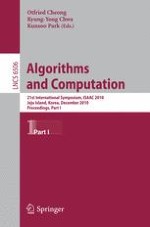2010 | OriginalPaper | Buchkapitel
Satisfiability with Index Dependency
verfasst von : Hongyu Liang, Jing He
Erschienen in: Algorithms and Computation
Verlag: Springer Berlin Heidelberg
Aktivieren Sie unsere intelligente Suche, um passende Fachinhalte oder Patente zu finden.
Wählen Sie Textabschnitte aus um mit Künstlicher Intelligenz passenden Patente zu finden. powered by
Markieren Sie Textabschnitte, um KI-gestützt weitere passende Inhalte zu finden. powered by
We study the Boolean Satisfiability Problem (SAT) restricted on input formulas for which there are linear arithmetic constraints imposed on
the indices of variables occurring in the same clause
. This can be seen as a structural counterpart of Schaefer’s dichotomy theorem which studies the SAT problem with additional constraints on
the assigned values of variables in the same clause
. More precisely, let
k
-SAT(
$m,\mathcal{A}$
) denote the SAT problem restricted on instances of
k
-CNF formulas, in every clause of which the indices of the last
k
−
m
variables are totally decided by the first
m
ones through some linear equations chosen from
$\mathcal{A}$
. For example, if
$\mathcal{A}$
contains
i
3
=
i
1
+ 2
i
2
and
i
4
=
i
2
−
i
1
+ 1, then a clause of the input to 4-SAT(
$2,\mathcal{A}$
) has the form
$y_{i_1}\lor y_{i_2} \lor y_{i_1+2i_2} \lor y_{i_2-i_1+1}$
, with
y
i
being
x
i
or
$\overline{x_i}$
. We obtain the following results:
1
If
m
≥ 2, then for any set
$\mathcal{A}$
of linear constraints, the restricted problem
k
-SAT
$(m,\mathcal{A})$
is either in
P
or
NP
-complete assuming
P
≠
NP
. Moreover, the corresponding #SAT problem is always #
P
-complete, and the
Max
-SAT problem does not allow a polynomial time approximation scheme assuming
P
≠
NP
.
2
m
= 1, that is, in every clause only one index can be chosen freely. In this case, we develop a general framework together with some techniques for designing polynomial-time algorithms for the restricted SAT problems. Using these, we prove that for any
$\mathcal{A}$
, #2
-SAT
$(1,\mathcal{A})$
and
Max
-2-SAT
$(1,\mathcal{A})$
are both polynomial-time solvable, which is in sharp contrast with the hardness results of general #2
-SAT
and
Max
-2-SAT. For fixed
k
≥ 3, we obtain a large class of non-trivial constraints
$\mathcal{A}$
, under which the problems
k
-SAT
$(1,\mathcal{A})$
, #
k
-SAT
$(1,\mathcal{A})$
and
Max
-
k
-SAT
$(1,\mathcal{A})$
can all be solved in polynomial time or quasi-polynomial time.
